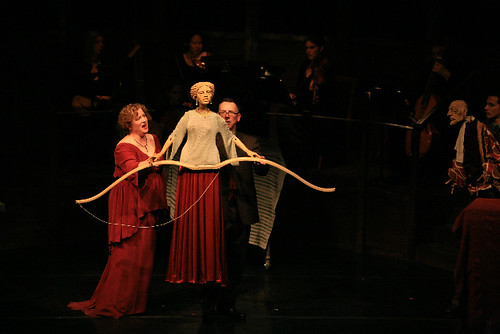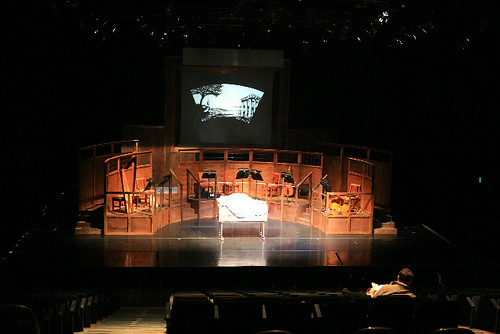The Return of Ulysses, redux
Last night was the glamorous opening night benefit for The Return of Ulysses. I wasn’t there (benefit=$$$$$), but I’m sure it was fabulous. I *was* at the preview/dress rehearsal on Tuesday night: it was curious, and delightful. The puppets (handcarved) are fantastic-looking and quite expressive, which was a surprise to me, grown-up puppet opera novice that I am, and the opera begins with an interesting set of allusions: Time, Fortune, and Love surround the bed of the dying Ulysses, singing of the fate of ‘the human, the mortal’, making it clear that life is fragile and rests in hands beyond human control. We witness the drama of this the-gods-they-roll-the-dice in quite explicit terms: The actors in this play are puppets. The story in one sentence: The faithful Penelope awaits the return of Ulysses, who, aided, abetted and manipulated as always by the gods, shows up in Ithaca in disguise, vanquishes some pesky suitors, and proves his true identity to his wife by telling boudoir secrets only he could know.
 ,
,The reunion of Ulysses and his son Telemachus is played out as a deathbed scene. L: Tenor Ross Hauck (Ulysses). R: Zachary Wilder (Telemachus). Photo: Aimee Friberg

L: Laura Pudwell (Penelope). R: Adrian Kohler, Handpring's master puppet designer and maker. Photo: Aimee Friberg
Above: Penelope offers Ulysses’s bow to potential suitors: whoever can bend the bow will win her hand. Of course none can. You can see here (I think) the way puppeteer and vocalist are collaborating on proper manipulation of the puppet. The vocalist is helping to carry the bow.
As I understand it, Kentridge’s decision to seat the instrumentalists in a permanent wooden stage frame (resembling an operating theater) is quite innovative for productions of this kind, solving a logistical problem of early baroque opera: acoustic proximity of the singers and their accompanists. This operating-theater stage set also has the interesting effect of making the instrumentalists actors in the drama as well as accompanists AND ‘audience’. The actual audience tucked away in the dark on the theater seats completes the medical-theater audience—does this implicate the audience as actor too? Not really/not at all. The screen above the instrumentalists is a version of scenery flat, with Kentridge’s trademark animated charcoal drawings, as well as surgical footage (of open-heart surgery), barium x-rays, and live-action shots of waves, water, and clouds. With musicians, puppets, puppeteers, vocalists, animations, and then the supertitles above, it was a lot to keep track of, but it was magical, I must admit.
Sorrily, the rest of the run is sold out. If I can retrieve a video clip and post it up, I will. Many more pre-show and preview pictures here. Joshua Kosman’s Chronicle review is here.
